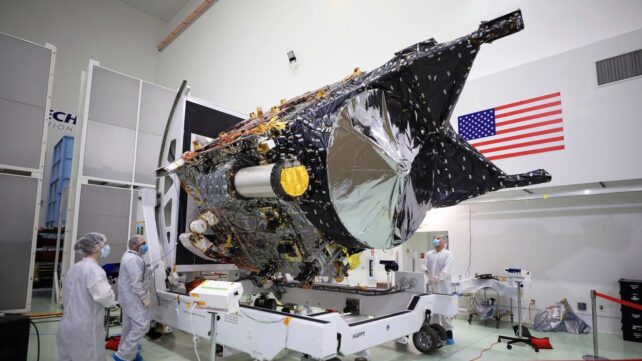Eventually, we’re going to want to expand the World Wide Web across the galaxy, and NASA recently demonstrated a key piece of tech that could help, beaming messages via laser across a distance of almost 16 million kilometers (10 million miles).
That’s about 40 times farther than the Moon is from Earth, and the accomplishment, achieved in November 2023, represented the first time that optical communications have been sent across such a distance.
Traditionally, we use radio waves to talk to distant spacecraft – but higher frequencies of light, such as near infrared, offer an increase in bandwidth and therefore a huge boost in data speed.
If we’re going to eventually be able to send high-definition video messages to and from Mars without a significant delay, then this is a step towards the tech we need.
The test was part of NASA’s Deep Space Optical Communications (DSOC) experiment, and the successful establishment of the comms link is known as ‘first light’.
“Achieving first light is one of many critical DSOC milestones in the coming months, paving the way toward higher-data-rate communications capable of sending scientific information, high-definition imagery, and streaming video in support of humanity’s next giant leap,” Trudy Kortes, who is director of Technology Demonstrations at NASA Headquarters, said at the time.
We all rely on similar tech built into optical fibers for our ground-based, high-speed communications, but here it was adapted for use through deep space to improve on existing methods of getting information back to Earth.
frameborder=”0″ allow=”accelerometer; autoplay; clipboard-write; encrypted-media; gyroscope; picture-in-picture; web-share” allowfullscreen>
Being infrared light, engineers can easily transmit its waves in laser form. This won’t get the light moving any faster, but it does tidy and constrain its beam to a narrow channel. This requires far less power than a scatter of radio waves and is harder to intercept.
That doesn’t mean it’s a simple task. Data bits are encoded in the photons emitted by the laser, which requires a number of heavy duty instruments – including a superconducting high-efficiency detector array – to prepare the information for transmission, and translate it at the other end.
Another challenge is having the system adapt its positioning configuration in real time. In this latest test, the laser photons took about 50 seconds to get from spacecraft to telescope, and both were hurtling through space while this was happening.
The laser transceiver that made the connection is on board the Psyche spacecraft, which is on a years-long mission, headed for the asteroid belt between Mars and Jupiter. It made contact with the Hale Telescope at the Palomar Observatory in California.

Psyche is scheduled for a fly-by around Mars, and so tests will continue to be carried out to refine and improve this innovative near-infrared laser communication method, and make sure it’s as fast and dependable as it needs to be.
“It was a formidable challenge, and we have a lot more work to do, but for a short time, we were able to transmit, receive, and decode some data,” said Meera Srinivasan, DSOC operations lead at the NASA Jet Propulsion Laboratory.
You can read more about DSOC here.
An earlier version of this article was published in November 2023.





